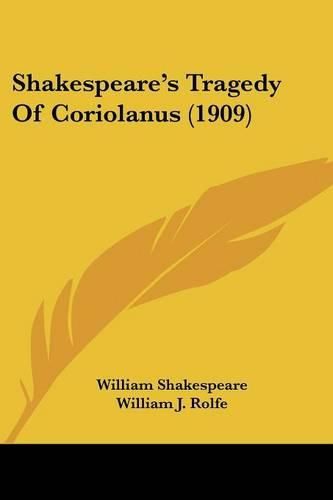Readings Newsletter
Become a Readings Member to make your shopping experience even easier.
Sign in or sign up for free!
You’re not far away from qualifying for FREE standard shipping within Australia
You’ve qualified for FREE standard shipping within Australia
The cart is loading…






Purchase of this book includes free trial access to www.million-books.com where you can read more than a million books for free. This is an OCR edition with typos. Excerpt from book: Roman V1ctoky NOTES Introduct1on The Metre Of The Play. ? It should be understood at the outset that metre, or the mechanism of verse, is something altogether distinct from the music of verse. The one is matter of rule, the other of taste and feeling. Music is not an absolute necessity of verse; the metrical form is a necessity, being that which constitutes the verse. The plays of Shakespeare (with the exception of rhymed passages, and of occasional songs and interludes) are all in unrhymed or blank verse; and the normal form of this blank verse is illustrated by i. 1. 70 of the present play: Against the Roman state, whose course will on. This line, it will be seen, consists of ten syllables, with the even syllables (2d, 4th, 6th, 8th, and Ioth) accented, the odd syllables (1st, 3d, etc.) being unaccented. Theoretically, it is made up of five feet of two syllables each, with the accent on the second syllable. Such a foot is called an iambus (plural, iambuses, or the Latin iambi), and the form of verse is called iambic. This fundamental law of Shakespeare’s verse is subject to certain modifications, the most important of which are as follows: ? 1. After the tenth syllable an unaccented syllable (or even two such syllables) may be added, forming what is sometimes called a female line; as in i. I. 56: What work’s, my countrymen, in hand ? where go you ?
The rhythm is complete with the word go, the you being an extra eleventh syllable, as it is in the next line also. In i. 3. 45 ( At Grecian sword contemning.?Tell Valeria ) we have two extra syllables, the rhythm being complete with the first syllable of Valeria; and the same is true of many lines ending with Aufidius, Cominius, Volumnia, etc. 2. The accent in any part of the verse may be shifted fro…
$9.00 standard shipping within Australia
FREE standard shipping within Australia for orders over $100.00
Express & International shipping calculated at checkout
Purchase of this book includes free trial access to www.million-books.com where you can read more than a million books for free. This is an OCR edition with typos. Excerpt from book: Roman V1ctoky NOTES Introduct1on The Metre Of The Play. ? It should be understood at the outset that metre, or the mechanism of verse, is something altogether distinct from the music of verse. The one is matter of rule, the other of taste and feeling. Music is not an absolute necessity of verse; the metrical form is a necessity, being that which constitutes the verse. The plays of Shakespeare (with the exception of rhymed passages, and of occasional songs and interludes) are all in unrhymed or blank verse; and the normal form of this blank verse is illustrated by i. 1. 70 of the present play: Against the Roman state, whose course will on. This line, it will be seen, consists of ten syllables, with the even syllables (2d, 4th, 6th, 8th, and Ioth) accented, the odd syllables (1st, 3d, etc.) being unaccented. Theoretically, it is made up of five feet of two syllables each, with the accent on the second syllable. Such a foot is called an iambus (plural, iambuses, or the Latin iambi), and the form of verse is called iambic. This fundamental law of Shakespeare’s verse is subject to certain modifications, the most important of which are as follows: ? 1. After the tenth syllable an unaccented syllable (or even two such syllables) may be added, forming what is sometimes called a female line; as in i. I. 56: What work’s, my countrymen, in hand ? where go you ?
The rhythm is complete with the word go, the you being an extra eleventh syllable, as it is in the next line also. In i. 3. 45 ( At Grecian sword contemning.?Tell Valeria ) we have two extra syllables, the rhythm being complete with the first syllable of Valeria; and the same is true of many lines ending with Aufidius, Cominius, Volumnia, etc. 2. The accent in any part of the verse may be shifted fro…